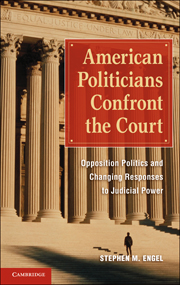 American Politicians Confront the Court
American Politicians Confront the Court Book contents
- Frontmatter
- Contents
- Acknowledgments
- Introduction
- PART I POLITICAL DEVELOPMENT AND ELECTED-BRANCH RELATIONS WITH THE JUDICIARY
- 1 Beyond the Countermajoritarian Difficulty
- 2 A Developmental Theory of Politicians' Confrontations with Judicial Authority
- PART II HOSTILITY TO JUDICIAL AUTHORITY AND THE POLITICAL IDIOM OF CIVIC REPUBLICANISM
- PART III HARNESSING JUDICIAL POWER AND THE POLITICAL IDIOM OF LIBERAL PLURALISM
- On the Return of Opposition Illegitimacy and the Prospects for New Development
- Index
- References
2 - A Developmental Theory of Politicians' Confrontations with Judicial Authority
Published online by Cambridge University Press: 05 June 2012
- Frontmatter
- Contents
- Acknowledgments
- Introduction
- PART I POLITICAL DEVELOPMENT AND ELECTED-BRANCH RELATIONS WITH THE JUDICIARY
- 1 Beyond the Countermajoritarian Difficulty
- 2 A Developmental Theory of Politicians' Confrontations with Judicial Authority
- PART II HOSTILITY TO JUDICIAL AUTHORITY AND THE POLITICAL IDIOM OF CIVIC REPUBLICANISM
- PART III HARNESSING JUDICIAL POWER AND THE POLITICAL IDIOM OF LIBERAL PLURALISM
- On the Return of Opposition Illegitimacy and the Prospects for New Development
- Index
- References
Summary
This chapter lays out a theory of elected branch-judiciary relations, which anchors individual interests and strategies in perceptions, ideas, and norms. It offers an explanation of the observed shift, detailed in Chapter 1, in emphasis of attacks on judicial authority, that is, a move from undermining judicial legitimacy to harnessing judicial power, which, in its general outlines, pivots the years of Civil War and Reconstruction.
Strategic-interest models offer one possible explanation for the harnessing strategy: deference to judicial authority may serve political purposes. Yet, many of these theories tend to take preferences as given – even if they are institutionally constrained – and hold the underlying parameters of rationality constant; the ideas and norms constituting the boundaries of rationality and structuring the range of legitimate political choices are not themselves closely scrutinized. In short, they “relegate ideas, however they are conceived, to the sidelines in explanatory accounts of political processes.” As such, ideas are often viewed as derivative of or epiphenomenal to interests rather than constituting them.
However, entrenched ideas, like norms and institutions, limit and motivate political action. Entrenched ideas constrain how challenges to a political regime can take shape: “challengers to a dominant regime do not operate in an empty playing field, but are forced to challenge inherited norms and institutions, or to adapt their insurgency to the regime they seek to dislodge.” Political agents are situated in an inherited regime of ideas and institutions that set the boundaries and delimit the range of legitimate preferences.
- Type
- Chapter
- Information
- American Politicians Confront the CourtOpposition Politics and Changing Responses to Judicial Power, pp. 43 - 68Publisher: Cambridge University PressPrint publication year: 2011
References
- 1
- Cited by


